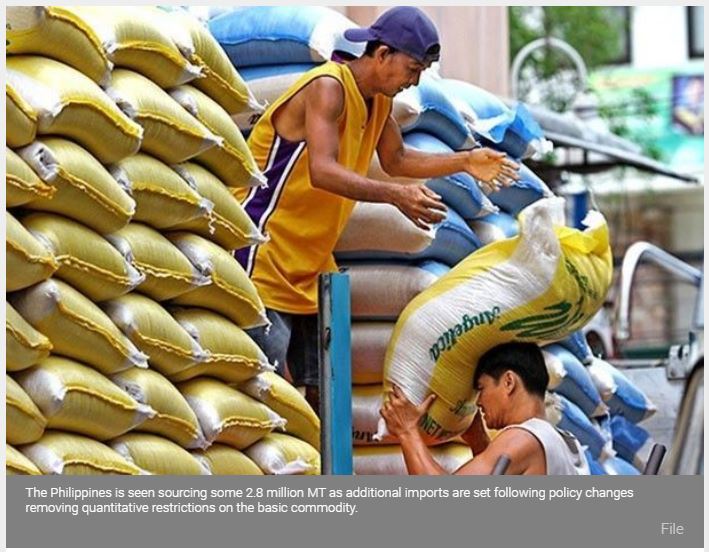Philippines to import more rice despite higher production
MANILA, Philippines — Amid a new rice regime, the Philippines is seen increasing its imports for the year to 2.8 million metric tons despite an expected improvement in local production of Filipinos’ main staple.
The Philippines is seen sourcing some 2.8 million MT as additional imports are set following policy changes removing quantitative restrictions on the basic commodity.
In the latest report of the United States Department of Agriculture-Foreign Agricultural Service (USDA-FAS), this year’s importation is 47 percent higher than the 1.9 million MT imports in 2018.
The latest projection is also higher than the earlier 2.6 million MT forecast for the Philippines.
“The quantitative restrictions on rice imports have been replaced with tariffs, with a tariff advantage for the ASEAN member countries. Consumption is expected to rise on both abundant local supplies and relatively low-priced imports,” USDA said.
“There are rapid purchases amid new import policies,” it added.
With the latest forecast, the Philippines is still setting record levels in terms of buying rice in the world market as it remains to be the second-largest global importer this year, next to China with an estimated four million MT of rice imports.
Two months ago, Republic Act 11203 or the Rice Import Liberalization Law took effect, which replaced rice import quantitative restrictions with tariffs and reverted the Minimum Access Volume to its 2012 levels.
Rice is a staple food in the country and the law is intended, in part, to spur imports in order to quell domestic unrest caused by inflation.
Higher imports are also expected despite a significant increase in local output as domestic consumption remains to be on upward trend.
Production of milled-rice this year is seen inching up by two percent to 12.2 million MT from the 12 million MT in 2018.
Further, rice consumption has been raised to 14.45 million MT from 13.9 million MT as rising food prices are forcing less affluent Filipinos to consume more rice and less meat and vegetables.
USDA said there is an improvement in area planted as rice areas in 2019 will be at 4.85 million hectares, one percent higher than the 4.81 million hectares last year.
Yield is also expected to improve to 3.99 metric tons per hectare per harvest from the earlier 3.96 MT.
Meanwhile, global rice production this year is forecast down with smaller crops in top-producing countries of China and India.
In contrast, global consumption is forecast to rise, particularly in Sub-Saharan Africa where affordable Asian rice is growing as a staple for a rising population.
Global trade is forecast at a near-record level, with India continuing to dominate exports. Notably, while China is the top importer, it has also grown in prominence as a significant exporter.
Global stocks are up, with China accounting for 68 percent of the total. The increase in stocks, both globally and in China, is the smallest in a decade.
Source: https://www.philstar.com/business/2019/05/13/1917282/philippines-import-more-rice-despite-higher-production#CyM6hq60z36CSXwY.99


 Thailand
Thailand




